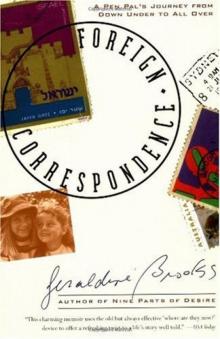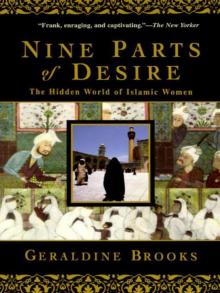- Home
- Geraldine Brooks
Nine Parts of Desire (Korean Edition) Page 2
Nine Parts of Desire (Korean Edition) Read online
Page 2
Sahar had joined a women’s study group at a local mosque and had been influenced by the young, veiled, woman instructor. “I would sit there and read in the holy Koran that women should be covered, and then walk out into the street with bare arms,” she said. “It just seemed to me that I was dressing that way because it was Western. Why imitate everything Western? Why not try something of our own?”
That “something” took many forms. Extremists rampaged down the Pyramids road, torching tourist clubs that served alcohol. In rural Egypt a sheik urged a ban on the sale of zucchini and eggplants, because stuffing the long, fleshy vegetables might give women lewd thoughts. In Cairo a writer mocking that pronouncement was gunned down and killed outside his office. Yet, when an earthquake convulsed the city, fundamentalists set up tent camps and soup kitchens, caring for the afflicted with a speed and compassion that had eluded the government.
As the weeks passed, Sahar drifted deeper into her new identity. I began to adjust my secular life to accommodate her, giving up coffee on Ramadan mornings in case the aroma made it harder for her to get through her fast; treading softly as she made her midday devotions on a prayer mat spread out in our living room. There were minefields everywhere. “What is a maraschino cherry?” she asked, suspiciously eying the contents list on a box of chocolates. “I can’t eat anything with alcohol inside.” Slowly, I became familiar with the rhythms and taboos of her new life. The evocative names of her festivals started to make their way onto our calendar: the Night of Power; the Feast of Sacrifice, the Hajj.
Sahar seemed comfortable with her new self. “I was up most of the night sewing,” she said one morning when she’d arrived for work bleary-eyed. Now that she had adopted hijab, she’d given away most of her bright dresses. But she hadn’t wanted to abandon the entire contents of her wardrobe. “Everything had something wrong with it—a slit in the back, a tight waistband—it’s really a lot of work to salvage a few outfits.”
Hijab, she said, gave her security on Cairo’s bustling streets. “You never hear about veiled girls being raped,” she said. In fact, it was unusual to hear about anyone being raped in Cairo, where violent crimes of all kinds were rare by the standards of Western cities. But bottom-fondling and suggestive comments were a hazard, especially in crowded quarters, especially for women in Western dress.
Sahar felt hijab also gave her access to an unusual women’s network. Prying permits and appointments out of government departments became easier if she sought out other veiled women among the bureaucrats working there. Wanting to see an Islamic sister succeed in her job, they’d give her requests a preferential push. At the same time, she felt easier dealing with men. “They have to deal with my mind, not my body,” she said.
Dress was only the beginning, she said. The West’s soaring crime rate, one-parent families and neglected elderly proved to Sahar the bankruptcy of our secular ways. At the root of it, to her, was Western feminism’s insistence on an equality of the sexes that she felt ignored women’s essential nature. “Islam doesn’t say women are inferior to men; it says they are different,” she argued, trying to explain the ban on women judges in some Islamic courts. “Women are more emotional than men, because God has designed them to care for children. So, in court, a woman might show mercy where logic demands harshness.”
Talking to Sahar gave me a feeling of deja vu. When I was fourteen years old, a convent girl in a Sydney Catholic school, the deputy head nun called us to assembly and read us the riot act. Some of us had been seen in the streets wearing our school sweaters without blazers over them. Sweaters, she said, were indecent, since boys would be able to make out the shape of our breasts. The school uniform included a blazer, and if any of us ventured out of the grounds in a sweater without a blazer over it, she would know what kind of girls we were. That same nun insisted we wear hats in church. Quoting St. Paul, she told us that woman, as the instrument of man’s downfall in Eden, wasn’t fit to appear bareheaded in the house of the Lord.
I thought the nun was a fossil. I stopped going to church as soon as I understood how Catholicism’s ban on birth control and divorce could ruin women’s lives. Sahar, a woman of my own generation, had made a choice exactly opposite to mine. Something was going on here, and I determined to try to understand it.
I started with Arabic, the language of the Koran. Only one in five Muslims is an Arab; yet Arabic is the language in which the world’s more than one billion Muslims—a fifth of the world’s population—talk to God.
The Arabic language is as tribal as the desert culture that created it. Each word trails a host of relatives with the same three-letter cluster of consonants as its root. Use almost any word in Arabic, and a host of uninvited meanings barge into the conversation. I learned that one of the words for woman, hormah, comes from the same root as the words for both “holy, sacrosanct,” and “sinful, forbidden.” The word for mother, umm, is the root of the words for “source, nation, mercy, first principle, rich harvest; stupid, illiterate, parasite, weak of character, without opinion.” In the beginning was the word, and the word, in Arabic, was magnificently ambiguous.
The nature of the Arabic language meant that a precise translation of the Koran was unobtainable. I found myself referring to two quite different English interpretations—George Sale’s for a feel for the poetry of the work, and Mohammed Marmaduke Pickthall’s for a clearer sense of what the text actually said about sex and marriage, work and holy war. But even when the language was clear the message was often mixed. “Respect women, who have borne you,” the Koran says. But if wives are disobedient, “admonish them, send them to beds apart, and scourge them.” To try to reconcile such conflicting instructions, I sat in on classes at the new women’s religious schools springing up throughout the region, and learned about the dozens of women who shaped the early history of Islam. Again, ambivalence. Women behind the curtain of seclusion; women at the forefront of Islamic holy war.
Meanwhile, in Afghanistan, Algeria and Sudan, Islamic fundamentalists were struggling into power. In Egypt and Jordan powerful minorities pushed their governments toward sharia—literally, the road to the water hole, or the straight path of Islamic law. Muslims migrating to the West also were making demands: ban offensive books, let our daughters wear veils to school, give us sex-segregated classrooms.
Was it possible to reclaim the positive messages in the Koran and Islamic history, and devise some kind of Muslim feminism? Could Muslim fundamentalists live with Western liberals, or would accommodating each other cost both of us our principles?
To find the answers, I did something so obvious I couldn’t believe it had taken me a year to get around to it. I started talking to women.
Chapter 1
THE HOLY VEIL
“Tell the believing women to lower their gaze and be modest and to display of their adornment only that which is apparent and to draw their veils over their bosoms.”
THE KORAN
THE CHAPTER OF THE LIGHT
As the bus full of women inched and squealed its slow way through Tehran traffic toward Khomeini’s home, I was the only one aboard who wasn’t weeping. We eased to a stop beside a black-bannered alley. The keening gained pitch, like a whistling kettle reaching the boil. At the end of the alley was Khomeini’s house and the small adjoining husseinya where he’d prayed and preached until just before his death five weeks earlier. Drenched with sweat and trying not to trip on my chador, I filed off the bus and joined the tight black phalanx, making its way down the alley with sobbing chants of “O Khomeini! O Imam!”
Ahead of us, a group of men entered the husseinya. They were factory workers from the city of Mashad, rubbing their tear-stained faces with callused fists. The balcony from which Khomeini used to speak had been hastily glassed in since his death because mourners had been shinnying up over the railing to kiss and fondle his chair. Our group turned aside from the husseinya to a curtained entrance flanked by female Revolutionary Guards. Under their chadors—the big black squar
es of fabric tossed over the head and falling to the ankles—the guards wore the same olive-drab uniform with its emblem of a rifle, Koran and clenched-fist as their male counterparts. Behind the curtain, Khomeini’s widow waited to serve us tea.
In one corner of a cracked concrete courtyard, she sat flanked by her daughter and daughter-in-law. With chadors pulled tight around their squatting figures, they looked like a trio of ninepins waiting for a bowling ball. Khomeini’s wife Khadija, at seventy-five, had the crinkly face of a kindly grandmother. She peered through wire-rimmed glasses, smiling as she reached up a gnarled hand to greet me. When she held my hand and patted it gently, her chador slid backward to reveal a half inch of silver roots topped by a tumble of carrot-colored curls. Until her husband’s death, Khadija had dyed her hair.
Somehow, I’d never imagined that the stony-faced ayatollah had a wife—certainly not one with vamp-red hair. And I hadn’t pictured him with the cute, giggling great-grandchildren who romped around us in the carpet-strewn courtyard. “I know that when you saw him he looked very serious, even angry,” said Zahra Mostafavi, Khomeini’s forty-seven-year-old daughter. “But he wasn’t like that with us. With children he made so many jokes. He used to let us hide under his robes when we were playing hide-and-seek.” According to Zahra, Khomeini had been quite the sensitive, New Age man, getting up in the night when his five children were infants to take turns giving them their bottles and never asking his wife to do anything for him—“not even to bring him so much as a glass of water.” The family snapshots being passed showed the ayatollah laughing merrily as a plump-fisted toddler tried to aim a spoonful of food at his greatgrandfather’s mouth.
We squatted alongside the Khomeini womenfolk on red Persian rugs spread over the concrete. “The carpets are all borrowed. The family doesn’t own anything this good,” explained one of the Revolutionary Guards who had worked as household help as well as bodyguard to Khadija for six years. Handing us plastic plates with pictures of ducks on them, she offered dates and slices of watermelon. “I’m sorry we have received you so simply,” Khadija said. “But all through his eighty-seven years of life my husband insisted on simplicity.”
Ruhollah, an impoverished clerical student from the dusty village of Khomein, had been twenty-seven when he asked for the hand of fifteen-year-old Khadija Saqafi. Her father, a prominent ayatollah (the word, meaning “reflection of God,” is applied to the most learned of the Shiite clergy), didn’t think much of the match. But Khadija felt differently. She had glimpsed her suitor when, wrapped in a chador, she brought him a glass of tea. She convinced her father to agree to the match after relating a dream in which the prophets proclaimed Ruhollah from Khomein as destined to become a great religious leader.
She had been his only wife. Her public profile had been so low that most Iranians didn’t even know her real name. “Someone made a mistake once and wrote that her name was Batul, which was actually the name of her servant,” Zahra explained. “My mother hates the name Batul.” Still, the name stuck, because the ayatollah would have frowned on calling attention to his wife by asking for a correction. Despite her public anonymity, insiders knew that Khadija’s influence counted. Men who wanted Khomeini’s ear, even on matters of state policy, would have their wives raise the issue with Khadija.
The Khomeinis’ boxy, two-floor house contrasted sharply with the opulent green marble palace of the former shah, now open nearby as the Museum of Reversion and Admonition. In the Khomeinis’ house, green paint peeled from the walls and a torn screen dangled from a window. In one bare room, the thin mats that served as beds were rolled up and piled in a corner. In the kitchen, an old-fashioned stove and an electric samovar were the only appliances. “Once, when the imam saw that two pomegranate seeds had fallen in the sink, he reminded me not to waste food,” said the Revolutionary Guard who had been waiting on us. “He was always reminding us to turn the lights off when we left a room.”
Every small reminiscence brought a new flood of tears from the other guests. One of the loudest weepers, a woman from Lebanon’s Hezbollah—the Party of God—rose to her feet and launched into an emotional speech of thanks to the imam’s widow for admitting us to the hallowed precincts of the imam’s home. “O God, please send us patience,” she sobbed. “We have come to this place where the great imam used to breathe. We have all gathered here in this holy place to show our allegiance to his way.”
The call to sunset prayer, wafting over the courtyard wall from a nearby mosque, was our signal that the tea party was over. In the corner, Khadija was already on her feet, on her way to wash for prayers. As we filed back into the bus, which nosed back through the traffic, the Hezbollah woman was still declaiming. “We have to divide our lives into two parts—before and after Imam’s death,” she sobbed. “We haven’t yet had time to understand the loss we’ve suffered.”
I, for one, hadn’t had time to understand it. After the U. S. Embassy occupation in 1979, Iran had been virtually closed to reporters from the American media. The rarely granted visas had usually allowed no more than thirty-six hours in the country to report on a specific event. Before Khomeini’s death, I’d been allowed in only once, in 1988, to cover the funerals of the 290 Iranian civilians killed when the cruiser U.S.S. Vincennes shot down an Iranian Airbus on a scheduled flight across the Persian Gulf.
But I needed to understand. What was happening to Muslim women from Algeria to Afghanistan had its roots here, in that austere, boxy house in North Tehran. Somehow, Khomeini had persuaded women that the wearing of a medieval cloak was a revolutionary act. Something in his message had brought thousands of women into the streets to face the shah’s army and risk their lives calling for the return of a code of laws that allowed child marriage, polygamy and wife beating.
Khomeini spoke with a voice that drew its authority from the earliest days of Islam. Khomeini was a Shiite, a member of the minority branch of Islam that had broken with the mainstream in the years following the prophet Muhammad’s death. The majority of the early Muslims agreed that their leader should be appointed by consensus of the elders, as was the long tradition of the desert. Since the Arabic word for “tradition” is sunnah, they became known as the Sunni Muslims. A minority, however, felt that Muhammad’s successor should come from within his own family, and chose his son-in-law and cousin, Ali. They were the Shiat Ali, or Partisans of Ali, known today as Shiites. Because of their origins as dissenters, Shiites hold it an obligation to question those in power, and revolt against them if necessary. And because their origins lay in the defeat of Ali and his sons, Shiites’ most profound identification is with the beaten and poor. Khomeini tapped all of those deep convictions when he launched the revolution against the shah in 1978.
When Khomeini died in June 1989, Iran opened its doors to any journalist who showed up. After the frantic funeral, Hashemi Raf-sanjani held a rare press conference for foreign reporters. I went, wearing a black chador. Because such events are always televised in Iran, I knew the press conference organizers wouldn’t let me near a microphone with so much as a hair showing. But when I finally got to put my question about the shape of the post-Khomeini power structure, Rafsanjani gazed at me, a hint of a smile playing on his moon-shaped face. “I have a question for you,” he said. “Why do you wear that heavy veil when a simple scarf would do?”
The huge, old-fashioned cameras of Iranian TV swung in my direction. What was I to say? That the chador was great camouflage for getting into places I wasn’t supposed to go? That I found its billowing folds less appallingly hot than the scarf-and-coat alternative? That just a day earlier the same dress had been deemed inadequate by one of the functionaries from the Ministry of Islamic Guidance? (I’d been running to board a helicopter to get to Khomeini’s graveside, and the gust from the rotor had momentarily blown the chador aside, revealing my trousers and shirt beneath. “Cover yourself!” the official yelled, his face full of loathing.)
Rafsanjani’s question was disingenuous. It took more th
an a simple scarf to escape the eighty-lash penalty with which Iran threatened women, even foreigners, who flouted the Islamic dress code. Along with hair, all skin except face and hands and all curves of the body had to be concealed. For a second, I wondered if I should do as the Italian journalist Oriana Fallaci had done, in an interview with Khomeini, and rip off the garment she’d dubbed a “filthy medieval rag.”
“I’m wearing it,” I said, “in a spirit of mutual respect.”
Rafsanjani looked taken aback. The two other Western women reporters at the press conference rolled their eyes. Later, I wished I’d spelled out more clearly what I’d meant to convey: that if I were prepared to respect Iranian society’s requirements, Iran should be prepared to respect mine. But to most Iranians, watching by the millions at home on TV for a hint about what their lives would be like after Khomeini, what I had said wasn’t important. What mattered was that Rafsanjani had sent them a signal of moderation. In the bazaar, the riyal surged against the dollar, as word went round that Rafsanjani had told a woman reporter she could take off her chador. To the traders, any signal of liberalism meant good news for business.
To one or two people, what I had said did matter. That night a member of Iran’s small Christian community called on me at my hotel, berating me for missing a chance to speak out against hijab on behalf of all the women who hated being forced to wear it. And a few days later Khomeini’s daughter Zahra invited me to a conference sponsored by the Women’s Society of the Islamic Republic of Iran titled “Aspects of His Highness Imam Khomeini’s Personality.” I studied the title with bemusement. The only aspects of His Highness Imam Khomeini’s personality I was familiar with were his penchants for condemning novelists to death, dispatching young boys to the war front as human minesweepers and permitting little girls to be married off at the age of nine.

 Year of Wonders
Year of Wonders People of the Book
People of the Book The Secret Chord
The Secret Chord Foreign Correspondence
Foreign Correspondence Nine Parts of Desire (Korean Edition)
Nine Parts of Desire (Korean Edition) Caleb's Crossing
Caleb's Crossing The Idea of Home
The Idea of Home Foreign Correspondence: A Pen Pal's Journey
Foreign Correspondence: A Pen Pal's Journey March
March March: a novel
March: a novel The Best American Short Stories® 2011
The Best American Short Stories® 2011 Nine Parts of Desire
Nine Parts of Desire